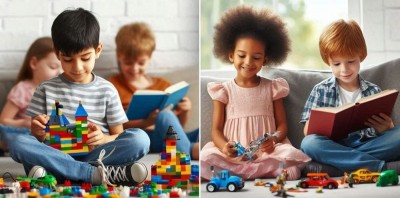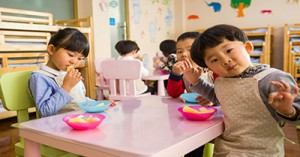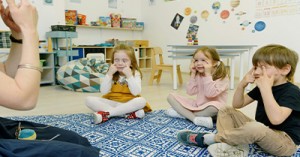The theme of this year's Children's Week is Article 24 of the United Nations Convention on the Rights of the Child (UNCRC) - Article 24 Children have the right to a clean and safe environment. The following article provides information on Article 24, Practical Strategies To Achieve A Clean and Safe Environment For Children and more.
Article 24
Article 24 emphasizes the right of children to the highest attainable standard of health. This includes the right to a clean and safe environment. Specifically, it states that children have the right to:
- Enjoy the best possible health and access to medical services.
- Benefit from efforts to combat disease and malnutrition.
- Live in an environment that supports their physical and mental well-being.
Ensuring a clean and safe environment is crucial for children’s overall development and well-being. This involves not only maintaining physical cleanliness and safety but also providing a nurturing and supportive atmosphere where children can thrive.
Creating such environments involves:
- Cleanliness: Regular cleaning and sanitizing of spaces where children play and learn to prevent the spread of germs and illnesses.
- Safety: Ensuring that the environment is free from hazards, such as sharp objects, toxic substances, and unsafe equipment.
- Healthy Practices: Promoting good hygiene practices among children, such as handwashing and proper waste disposal.
- Environmental Education: Teaching children about the importance of taking care of their surroundings and encouraging them to participate in activities like recycling and conserving resources.
- Supportive Policies: Implementing policies that protect children from environmental hazards and ensure their right to a safe and healthy environment.
By prioritizing these aspects, we can help children thrive in a nurturing and secure setting.
Practical Strategies To Achieve A Clean and Safe Environment For Children
Creating a clean and safe environment in the classroom is essential for fostering a positive and productive learning atmosphere. Here are some practical steps to achieve this:
Physical Environment
-
Regular Cleaning: Ensure that the classroom is cleaned regularly. This includes wiping down surfaces, vacuuming or mopping floors, and sanitizing high-touch areas like doorknobs and desks.
-
Organized Space: Keep the classroom organized with designated areas for different activities. Use storage bins, shelves, and labels to help children know where things belong.
-
Safe Materials: Use non-toxic, child-safe materials for all classroom activities. Check that toys and equipment are in good condition and free from hazards.
-
Proper Ventilation: Ensure the classroom is well-ventilated to provide fresh air and reduce the spread of germs. Open windows when possible and use air purifiers if needed.
-
Safety Checks: Regularly inspect the classroom for potential hazards such as loose wires, sharp edges, or broken furniture. Address any issues immediately.
Emotional and Psychological Safety
-
Inclusive Environment: Foster an inclusive environment where all children feel valued and respected. Celebrate diversity and encourage children to express themselves.
-
Clear Rules and Expectations: Establish clear rules and expectations for behavior. Consistently enforce these rules to create a predictable and safe environment.
-
Positive Reinforcement: Use positive reinforcement to encourage good behavior. Praise children for following rules and being kind to others.
-
Conflict Resolution: Teach children conflict resolution skills. Provide them with tools to express their feelings and resolve disagreements peacefully.
-
Safe Spaces: Create a designated safe space in the classroom where children can go if they feel overwhelmed or need a break. This can be a cozy corner with soft cushions and calming activities.
Health and Hygiene
-
Hand Hygiene: Teach and encourage regular handwashing, especially before meals and after using the restroom. Provide hand sanitizer for times when handwashing isn’t possible.
-
Healthy Snacks: Offer healthy snacks and encourage children to bring nutritious food from home. Avoid foods that can cause allergies or choking hazards.
-
Illness Policies: Have clear policies for when children should stay home if they are sick. Communicate these policies to parents and caregivers.
-
Emergency Preparedness: Have a plan in place for emergencies, such as fire drills or lockdown procedures. Practice these regularly with the children.
Engaging Activities
-
Nature-Based Activities: Incorporate nature-based activities that promote environmental awareness and appreciation. This can include outdoor play, gardening, and nature walks.
-
Interactive Learning: Use interactive and hands-on learning activities that engage children and make learning fun. This can include art projects, science experiments, and group games.
-
Mindfulness Practices: Introduce mindfulness practices such as deep breathing, yoga, or quiet reflection time to help children manage stress and stay focused.
By implementing these strategies, you can create a classroom environment that is not only clean and safe but also nurturing and supportive for all children.
Further Reading
UN Convention On The Rights of The Child
References:
Creating A Safe Environment, TeacherPh
Building A Safe Learning Environment, My Bright Wheel
25 Tips For Creating A Safe Environment, Periwinkle
UN Convention Of The Rights Of The Child







 As an Educator in Australia, your pay rate falls under the Children’s Services Award 2010. This award states the minimum amount that an employer can
As an Educator in Australia, your pay rate falls under the Children’s Services Award 2010. This award states the minimum amount that an employer can When working as a qualified Early Childhood Teacher (with a university degree) within a service, your rate of pay will come from the Educational Services
When working as a qualified Early Childhood Teacher (with a university degree) within a service, your rate of pay will come from the Educational Services When working as a Diploma Qualified Educator your pay rate is from the Children's Services Award 2010. This Award states your minimum rate of pay
When working as a Diploma Qualified Educator your pay rate is from the Children's Services Award 2010. This Award states your minimum rate of pay When working as a Cert 3 Qualified Educator, your pay rate is from the Children's Services Award 2010. This Award states your minimum rate of
When working as a Cert 3 Qualified Educator, your pay rate is from the Children's Services Award 2010. This Award states your minimum rate of Educational Leaders play a crucial role in their early childhood service by ensuring that the educational program aligns with best practices and supports the holistic
Educational Leaders play a crucial role in their early childhood service by ensuring that the educational program aligns with best practices and supports the holistic In early childhood education and care, ratios are more than a technicality—they are a frontline safeguard. Every child deserves responsive supervision, emotional connection, and developmental
In early childhood education and care, ratios are more than a technicality—they are a frontline safeguard. Every child deserves responsive supervision, emotional connection, and developmental With the new national child safety reforms kicking in on 1 September 2025, early childhood services like yours have a real opportunity to lead the
With the new national child safety reforms kicking in on 1 September 2025, early childhood services like yours have a real opportunity to lead the Here’s a comprehensive Mobile Phone and Smart Watch Policy tailored for early childhood education and care (ECEC) services in Australia, aligned with the latest 2025
Here’s a comprehensive Mobile Phone and Smart Watch Policy tailored for early childhood education and care (ECEC) services in Australia, aligned with the latest 2025 The Sea of Fish Challenge is a national initiative that invites children, educators, families, and communities to create and display fish artworks as a symbol
The Sea of Fish Challenge is a national initiative that invites children, educators, families, and communities to create and display fish artworks as a symbol Emotional awareness and self-regulation are crucial skills for young children, helping them navigate social interactions, manage their feelings, and develop resilience. The following article provides
Emotional awareness and self-regulation are crucial skills for young children, helping them navigate social interactions, manage their feelings, and develop resilience. The following article provides


